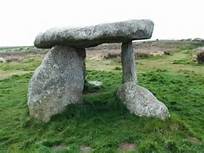CIRCLES AND STANDING STONES
CATEGORY: ENGLAND

How can one write about the English countryside without mentioning earth works: barrows, mounds, tumuli, tors, standing stones, circles? They seem to be everywhere. The first one I saw was near the Uffington White Horse. It was a circle about fifteen feet across. If England had buffalo, I would have thought it was a buffalo wallow, except that it was built up more around the edge. By the time I got to Avebury, the largest of them all, mystic mounds and circles were old hat. From then on, it seemed nothing to see one or more standing stones alone in a field with sheep or cattle grazing around them. Talk about wanting to go back in time to unravel mysteries!
Because I had not done a lot of studying about England, many things came as delightful surprises, such as the Uffington White Horse and a glimpse of Wells Cathedral through the mist. It was like wandering in a foreign land and stumbling accidentally upon pyramids, wondering who could have built them: why, how, when.
Now there are crop circles and intricate crop formations all over the world, even in the snow and on the thin ice of lakes with no foot prints visible. Mostly, though, they are in England, undoubtedly made by the ghosts of the first circle makers, but since then having acquired the skill to make them with extreme complexity.
